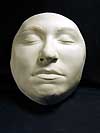Model (art)
Art modeling involves the posing of a model as an aid in creating a work of art. Models are frequently used for training art students, but are also employed by accomplished artists. The most common types of art created using models are figure drawing, figure painting, sculpture and photography. Although commercial motives dominate over the esthetics in advertising, its 'artwork' commonly employs models.
Throughout the history of Western Art, drawing the human figure from living models was considered the most useful tool in developing the skill of draftsmanship. In the art school classroom setting, the purpose is to learn how to draw humans of all different shapes, ages and ethnicities, so there are no real limitations on who the model can be. In some cases, the model may pose with various props, (an)other model(s), animal(s) etc., against real or artificial background, in natural or artificial light and so on.
Throughout the history of Western Art, drawing the human figure from living models was considered the most useful tool in developing the skill of draftsmanship. In the art school classroom setting, the purpose is to learn how to draw humans of all different shapes, ages and ethnicities, so there are no real limitations on who the model can be. In some cases, the model may pose with various props, (an)other model(s), animal(s) etc., against real or artificial background, in natural or artificial light and so on.




